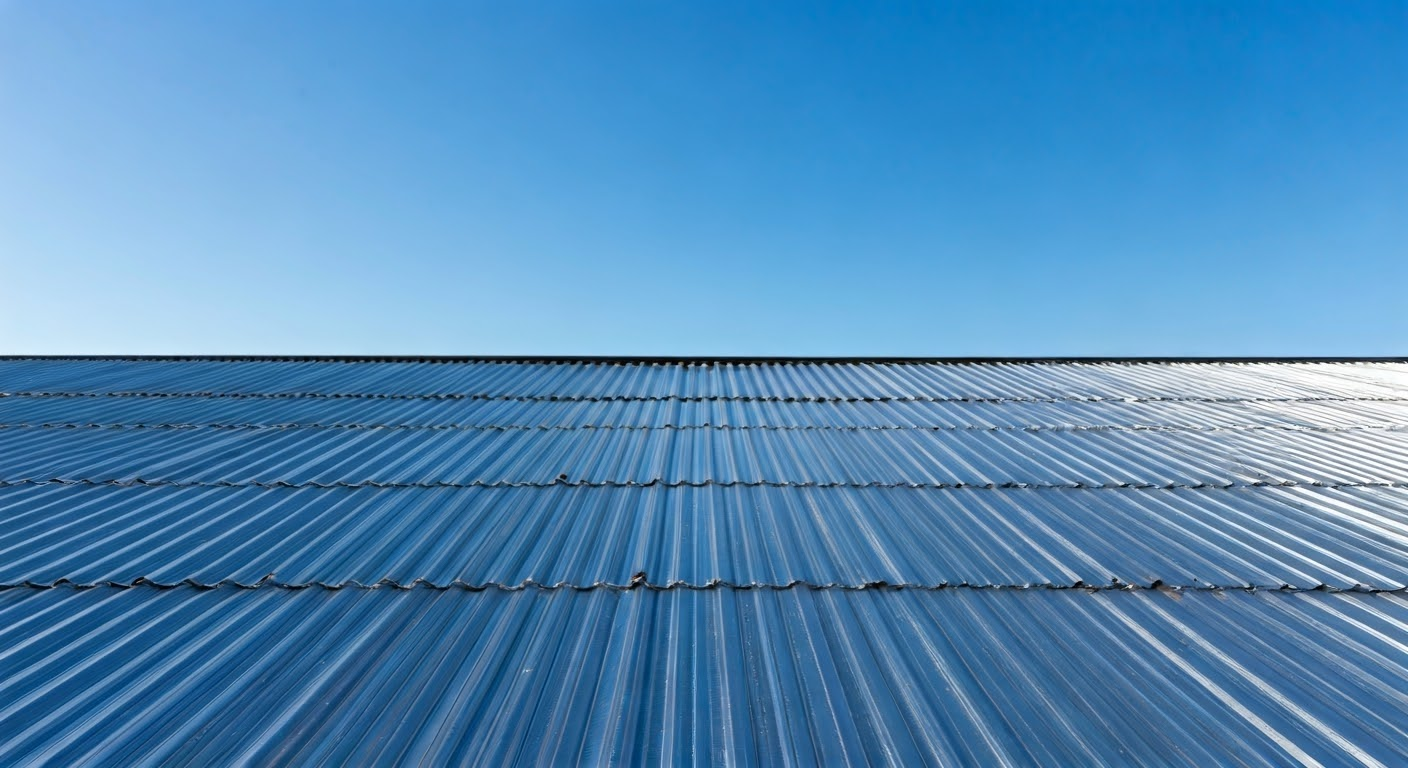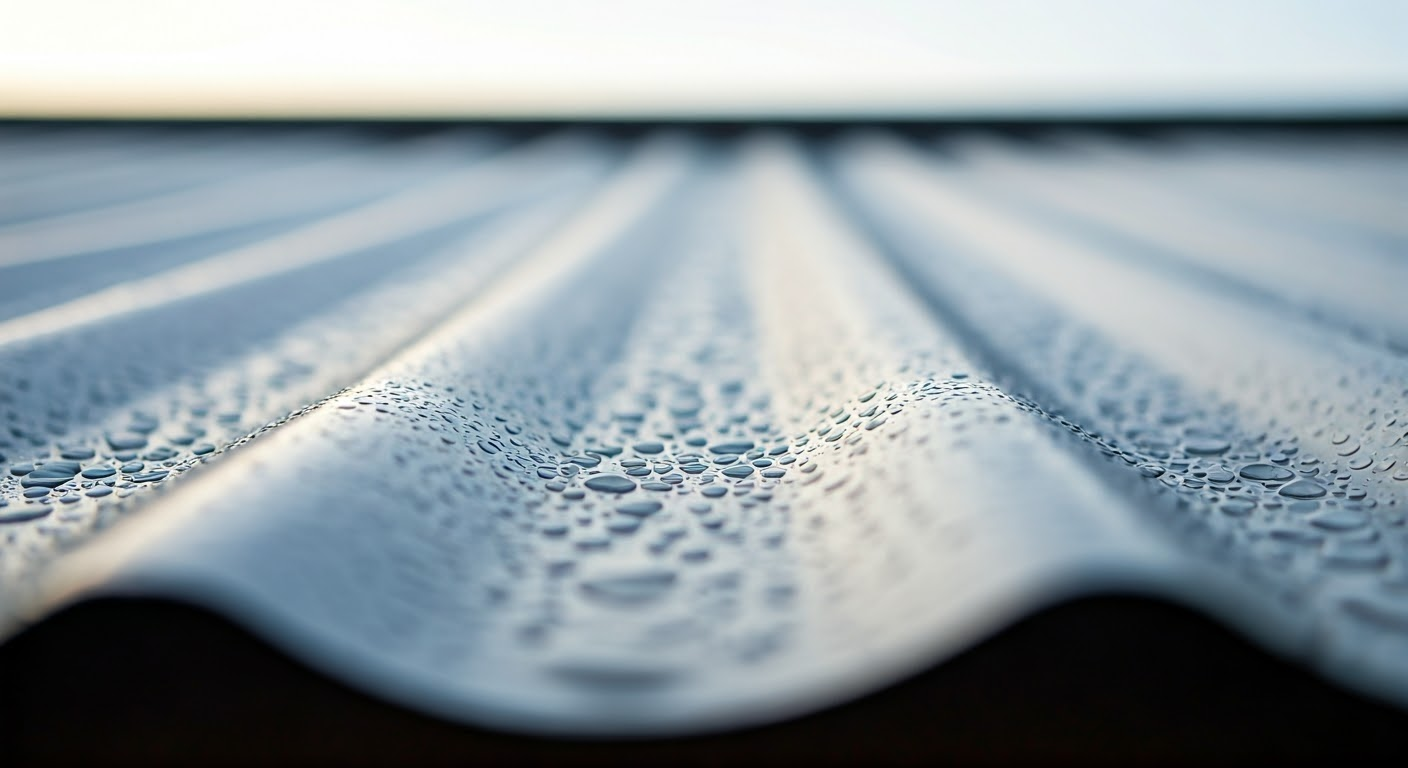
Key Highlights
- Metal roof condensation occurs when warm, humid air touches the cold surface of the metal roofing, forming water droplets.
- Poor insulation, ventilation issues, and high humidity are common causes of condensation.
- Excess condensation can lead to rust, mold growth, indoor air quality problems, and structural damage.
- Proactively preventing condensation is key to extending your metal roof’s lifespan and avoiding costly repairs.
- Using proper installation techniques and materials, such as vapor barriers and insulated underlayment, can significantly reduce condensation risks.
Introduction
Metal roof condensation is a frustrating problem for homeowners and can lead to significant damage if not addressed. It occurs when water vapor collects on the underside of the roof due to contrasting temperatures between the indoor environment and the cold metal panels. Without proper precautions, this condensation can degrade your home’s structure, promote rust and mold formation, and reduce your roof’s lifespan. Understanding why condensation happens and taking steps to prevent it are essential for homeowners with metal roofs. In this blog, we’ll explore expert strategies to keep condensation at bay.
Understanding Metal Roof Condensation

Condensation is a common phenomenon that impacts roofing materials, but it is especially concerning for metal roofs. The unique properties of metal make them vulnerable to moisture buildup when warm air interacts with their cold surfaces. This leads to structural complications over time.
For homeowners, recognizing the risks associated with condensation on roofing sheets is essential to maintaining a durable metal roof. The good news is that condensation can be prevented through smart planning, which includes choosing the right materials, ensuring proper ventilation, and installing effective insulation systems.
What is Condensation and How Does it Affect Metal Roofs?
Condensation occurs when warm, humid air meets a cold surface, leading to the formation of water droplets. On a metal roof, this happens primarily on the underside of the metal roofing panels, where moisture collects and creates issues.
For homeowners, condensation is more than just annoying—it poses serious risks. Over time, the constant absorption and evaporation of moisture can weaken the metal roof, promote rust formation, and attract mold in areas with limited ventilation.
Additionally, water vapor trapped beneath metal roofing can result in damp interiors and costly repairs. Failing to address condensation not only affects the roof’s condition but can adversely impact your home’s overall indoor air quality, so it’s vital to implement preventative measures.
The Science Behind Condensation in Metal Roofs
Condensation on metal roofs is closely linked to the dew point, which is the temperature at which water vapor in the air condenses into liquid form, leading to drips. The warm air inside your home interacts with the colder surface of the metal roofing, creating the perfect conditions for condensation.
When warm air collides with a metal roof’s cold underside, the temperature drops, reaching or falling below the dew point. As this process repeats, water droplets accumulate and increase moisture in the roofing system.
The interaction of warm air trapped inside the building and insufficient airflow worsens condensation issues. To counteract this, homeowners must prioritize proper ventilation, maintain consistent air circulation, and address temperature differences by using insulation or vapor barriers.
Identifying Condensation Issues on Your Metal Roof
Spotting condensation early is crucial to preventing extensive damage. Homeowners should look for signs such as water stains, rust, or mold growth in their roofing systems. Unpleasant odors in the attic or water droplets clinging to metal surfaces might indicate excess moisture.
Routine inspections of both the roof’s interior and exterior can help detect condensation problems in their early stages. Timely identification allows for swift corrective action and ensures the roof remains durable over the long term.
Signs and Symptoms of Condensation Damage
Condensation damage can manifest in several ways. Below is a text table outlining the common symptoms:
| Symptom | Description |
|---|---|
| Water Damage | Visible stains or leaks in ceilings/walls. |
| Rust | Oxidation on metal surfaces due to moisture. |
| Mold | Fungal growth from trapped water. |
Additionally, homeowners might notice musty odors inside the home or see deterioration of insulation materials. Left unchecked, these issues escalate, leading to compromised structural integrity or costly renovations.
Early detection is vital, and homeowners should regularly inspect the attic, walls, and roof areas for these warning signs.
Tools and Techniques for Spotting Condensation Early
To catch condensation in its early stages, homeowners can use a combination of tools and techniques. Moisture meters are helpful for measuring humidity levels in the attic space and drywall. Thermal cameras can reveal cold spots where condensation is likely to form.
Regular physical inspections are equally beneficial. Using flashlights to inspect the roof’s underside for signs of water droplets, rust, and discoloration is a practical method. Pay close attention to corners and areas with minimal airflow.
Maintaining a consistent inspection schedule and using the right equipment will help homeowners prevent moisture buildup before it becomes a larger issue.
Proactive Measures to Prevent Condensation
Preventing condensation starts with proactive measures that address key contributing factors: poor ventilation, inadequate insulation, and climate-related humidity. Homeowners should invest in advanced materials and installation techniques throughout construction.
These include using vapor barriers, adding insulation layers, and implementing smart ventilation strategies to enhance airflow. Taking preemptive action not only prevents moisture troubles but also ensures extended roof longevity with minimal maintenance needs.
Importance of Proper Installation and Materials
Proper installation and materials are the foundation for controlling condensation in metal roofing panels. Insulation plays a key role by preventing warm air from directly contacting the underside of the roof. Vapor barriers are another must-have, as they effectively block moisture from penetrating internal spaces.
Homeowners should also prioritize the best way to use professionally installed underlayment materials, such as Low-E or Fan-Fold insulation, which offer excellent thermal resistance and moisture control. Pairing these products with appropriate screws and fasteners ensures complete protection against condensation and leaks.
By investing in quality materials and expert installation practices, homeowners can safeguard their metal roofs from persistent moisture problems, creating a long-lasting roofing system.
Ventilation Strategies to Reduce Moisture
Ventilation is essential for preventing condensation buildup on metal roofs, as it facilitates steady airflow and prevents humid air from accumulating inside. Ridge vents, soffit vents, and attic fans are all effective tools to keep air circulating efficiently.
Homeowners should ensure that the entire roofing system is designed to allow warm air to escape, reducing the likelihood of moisture saturation. Additionally, pairing ventilation improvements with insulation layers enhances their effectiveness by regulating temperatures.
Properly installed ventilation systems not only mitigate condensation risks but also improve energy efficiency, making homes more comfortable year-round.
Conclusion
In summary, addressing condensation on metal roofs is crucial for maintaining their integrity and longevity. By understanding the science behind condensation and recognizing the signs early on, homeowners can take proactive measures to prevent damage. Implementing proper installation techniques, utilizing suitable materials, and ensuring adequate ventilation are essential steps in combating moisture-related issues. Regular maintenance and awareness can save you from costly repairs down the line. If you’re experiencing condensation issues or want to learn more about optimizing your metal roof, don’t hesitate to reach out to our experts for a consultation. Your roof deserves the best care!
At Metal Roof Mobile AL, we ensure our clients receive the best possible outcomes. Our commitment to quality workmanship and customer satisfaction is unwavering, making us the top choice for residential Roofing services in our community.
Frequently Asked Questions
What are the first steps to take if I notice condensation on my metal roof?
If you notice condensation on your metal roof, your immediate action should include drying the affected areas and assessing moisture-related damage. Next, check for ventilation issues and consider installing a vapor barrier or insulation to mitigate the problem. Consulting roofing professionals for guidance is also highly recommended.
